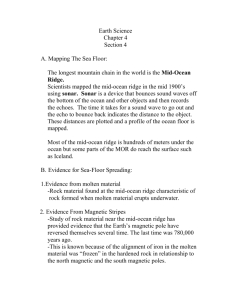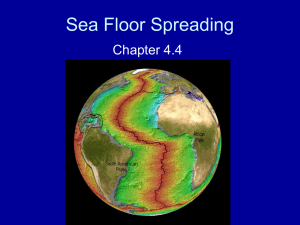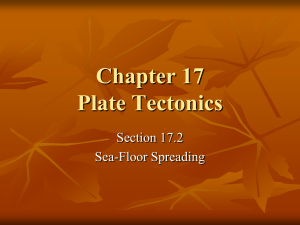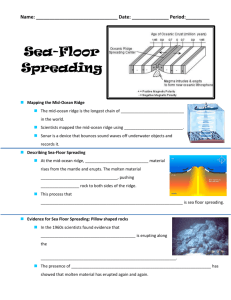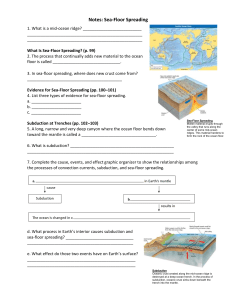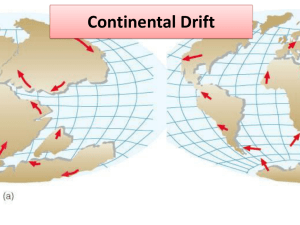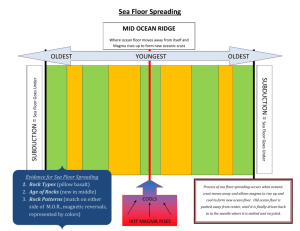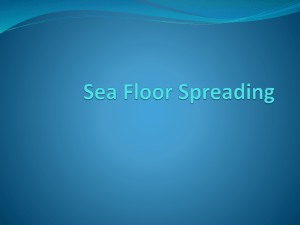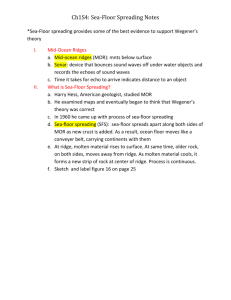4 Sea-Floor Spreading
advertisement
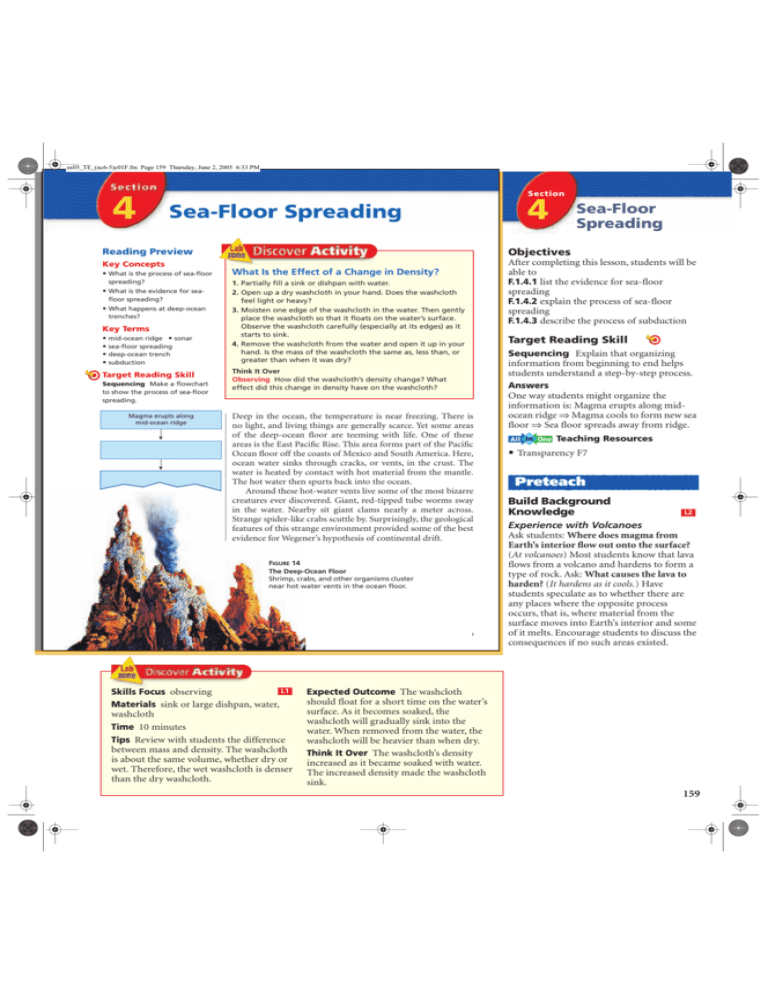
sx05_TE_(nc6-5)c01F.fm Page 159 Thursday, June 2, 2005 6:33 PM 4 Section 4 Sea-Floor Spreading Objectives Reading Preview Key Concepts • What is the process of sea-floor spreading? • What is the evidence for seafloor spreading? • What happens at deep-ocean trenches? Key Terms • mid-ocean ridge • sonar • sea-floor spreading • deep-ocean trench • subduction Target Reading Skill Sequencing Make a flowchart to show the process of sea-floor spreading. Magma erupts along mid-ocean ridge Sea-Floor Spreading What Is the Effect of a Change in Density? 1. Partially fill a sink or dishpan with water. 2. Open up a dry washcloth in your hand. Does the washcloth feel light or heavy? 3. Moisten one edge of the washcloth in the water. Then gently place the washcloth so that it floats on the water’s surface. Observe the washcloth carefully (especially at its edges) as it starts to sink. 4. Remove the washcloth from the water and open it up in your hand. Is the mass of the washcloth the same as, less than, or greater than when it was dry? Think It Over Observing How did the washcloth’s density change? What effect did this change in density have on the washcloth? Deep in the ocean, the temperature is near freezing. There is no light, and living things are generally scarce. Yet some areas of the deep-ocean floor are teeming with life. One of these areas is the East Pacific Rise. This area forms part of the Pacific Ocean floor off the coasts of Mexico and South America. Here, ocean water sinks through cracks, or vents, in the crust. The water is heated by contact with hot material from the mantle. The hot water then spurts back into the ocean. Around these hot-water vents live some of the most bizarre creatures ever discovered. Giant, red-tipped tube worms sway in the water. Nearby sit giant clams nearly a meter across. Strange spider-like crabs scuttle by. Surprisingly, the geological features of this strange environment provided some of the best evidence for Wegener’s hypothesis of continental drift. FIGURE 14 The Deep-Ocean Floor Shrimp, crabs, and other organisms cluster near hot water vents in the ocean floor. Chapter 5 L1 Skills Focus observing Materials sink or large dishpan, water, washcloth Time 10 minutes Tips Review with students the difference between mass and density. The washcloth is about the same volume, whether dry or wet. Therefore, the wet washcloth is denser than the dry washcloth. ◆ 159 After completing this lesson, students will be able to F.1.4.1 list the evidence for sea-floor spreading F.1.4.2 explain the process of sea-floor spreading F.1.4.3 describe the process of subduction Target Reading Skill Sequencing Explain that organizing information from beginning to end helps students understand a step-by-step process. Answers One way students might organize the information is: Magma erupts along midocean ridge ⇒ Magma cools to form new sea floor ⇒ Sea floor spreads away from ridge. Teaching Resources • Transparency F7 Preteach Build Background Knowledge L2 Experience with Volcanoes Ask students: Where does magma from Earth’s interior flow out onto the surface? (At volcanoes) Most students know that lava flows from a volcano and hardens to form a type of rock. Ask: What causes the lava to harden? (It hardens as it cools.) Have students speculate as to whether there are any places where the opposite process occurs, that is, where material from the surface moves into Earth’s interior and some of it melts. Encourage students to discuss the consequences if no such areas existed. Expected Outcome The washcloth should float for a short time on the water’s surface. As it becomes soaked, the washcloth will gradually sink into the water. When removed from the water, the washcloth will be heavier than when dry. Think It Over The washcloth’s density increased as it became soaked with water. The increased density made the washcloth sink. 159 sx05_TE_(nc6-5)c01F.fm Page 160 Thursday, June 2, 2005 6:33 PM Instruct Earth’s Ocean Floor Arctic Mid-Ocean Ridges Teach Key Concepts L2 Mountains on the Sea Floor Focus Ask students whether anyone has ever heard an echo of his or her voice. Point out that sonar sends and receives sound waves in a similar way. Teach Tell students that the ocean floor has mountain chains that are as impressive as those on land. Ask: How did scientists determine the location and size of the underwater mountain chain? (By using sonar) What are these underwater mountains called? (Mid-ocean ridges) Apply Remind students that Iceland is a portion of a mid-ocean ridge that rose above sea level. Ask them to characterize Iceland. (Students are likely to mention the frequent volcanic activity.) Tell students that volcanism is characteristic of the entire midocean ridge system. learning modality: Iceland Asia Atlantic • Guided Reading and Study Worksheet: Sea-Floor Spreading Student Edition on Audio CD 160 Indian Ocean Australia Indian Ocean Key Deep-ocean trench Mid-ocean ridge Antarctica FIGURE 15 The mid-ocean ridge system is more than 50,000 kilometers long. Interpreting Maps What is unusual about Iceland? Materials baseball Time 20 minutes Teaching Resources Ocean South America Visualizing Mid-Ocean Ridges L2 Asia Africa Pacific Ocean L1 Focus Have students compare the shape of a baseball with the shape of Earth. Teach Allow students to see and feel the seam that circles a baseball. Ask each student to write a short paragraph about how a baseball’s seam is similar to the mid-ocean ridge system. (Students realize that the seam is continuous on a baseball, just as the mid-ocean ridge system is nearly continuous around Earth.) Apply Emphasize that a baseball’s seam is raised above the rest of the ball and that a “valley” exists at the center of the seam. Draw parallels with the mid-ocean ridge system. learning modality: visual Europe North America verbal Independent Practice Ocean Mid-Ocean Ridges The East Pacific Rise is just one of many mid-ocean ridges that wind beneath Earth’s oceans. In the mid-1900s, scientists mapped the mid-ocean ridges using sonar. Sonar is a device that bounces sound waves off underwater objects and then records the echoes of these sound waves. The time it takes for the echo to arrive indicates the distance to the object. Mid-ocean ridges curve like the seam of a baseball along the sea floor. They extend into all of Earth’s oceans. Figure 15 shows the location of these ridges. Most of the mountains in the mid-ocean ridge system lie hidden under hundreds of meters of water. But in a few places the ridge pokes above the surface. For example, the island of Iceland is a part of the midocean ridge that rises above the surface in the North Atlantic Ocean. A steep-sided valley splits the top of some mid-ocean ridges. The mapping of mid-ocean ridges made scientists curious to know more about them. What are the ridges? How do they form? What device is used to map the ocean floor? 160 ◆ sx05_TE_(nc6-5)c01F.fm Page 161 Thursday, June 2, 2005 6:33 PM What Is Sea-Floor Spreading? Harry Hess, an American geologist, was one of the scientists who studied mid-ocean ridges. Hess carefully examined maps of the mid-ocean ridge system. Then he began to think about the ocean floor in relation to the problem of continental drift. Finally, he reached a startling conclusion: Maybe Wegener was right! Perhaps the continents do move. In 1960, Hess proposed a radical idea. He suggested that a process he called sea-floor spreading continually adds new material to the ocean floor. In sea-floor spreading, the sea floor spreads apart along both sides of a mid-ocean ridge as new crust is added. As a result, the ocean floors move like conveyor belts, carrying the continents along with them. Look at Figure 16 to see the process of sea-floor spreading. Sea-floor spreading begins at a mid-ocean ridge, which forms along a crack in the oceanic crust. Along the ridge, molten material that forms several kilometers beneath the surface rises and erupts. At the same time, older rock moves outward on both sides of the ridge. As the molten material cools, it forms a strip of solid rock in the center of the ridge. When more molten material flows into the crack, it forms a new strip of rock. How does new oceanic crust form? New rock added to each side of the mid-ocean ridge What Is Sea-Floor Spreading? PHSchool.com For: More on sea-floor spreading Visit: PHSchool.com Web Code: cfd-1014 FIGURE 16 Sea-Floor Spreading Molten material erupts through the valley that runs along the center of some mid-ocean ridges. This material hardens to form the rock of the ocean floor. Applying Concepts What happens to the rock along the ridge when new molten material erupts? Teach Key Concepts L2 Sea-floor Spreading Focus Review with students Wegener’s hypothesis of continental drift. Teach Work together as a class to summarize the process of sea-floor spreading. (A crack develops along a midocean ridge. Magma is injected into the space and cools to form new ocean floor. The sea floor spreads more to form a new crack.) Ask: How does sea-floor spreading help support the idea that continents drift? (It provides a partial explanation of how oceanic crust and continents could move.) Why was this not known during Wegener’s lifetime? (Sonar and deep-diving vessels were not available to identify and explore the mid-ocean ridges.) Apply Ask: Is sea-floor spreading occurring today? (Yes) Why don’t we notice the movement? (It is very slow and gradual. The sea floor and the continents generally move at rates of a few centimeters each year.) learning modality: verbal For: More on sea-floor spreading PHSchool.com Visit: PHSchool.com Web Code: cfd-1014 Students can review sea-floor spreading in an online activity. Monitor Progress Oceanic crust Molten material Chapter 5 ◆ 161 Differentiated Instruction L1 Special Needs Demonstrating Sea-Floor Spreading To help students better understand the process of sea-floor spreading, place two chairs about a meter apart at the front of the room. Then have students form two lines to the back of the room. At your word, they should move in pairs through the opening and then turn away from each other, spreading out horizontally to the edges of the room. Ask: What do the chairs represent? (The mid-ocean ridge) What does the space between the chairs represent? (The valley in the center of the ridge) What do the students represent? (First, the molten material from the mantle; then the spreading sea floor) learning L2 Drawing Distribute a map showing the outlines of the world’s continents, and challenge students to draw the mid-ocean ridge system on the map. Have them compare their drawings to Figure 15 and make corrections as necessary. Have students place their drawings in their portfolios. Answers Figure 15 A mid-ocean ridge cuts through Iceland. Figure 16 The rock spreads away fromthe ridge. Sonar It forms when lava is erupted onto the sea floor. modality: kinesthetic 161 sx05_TE_(nc6-5)c01F.fm Page 162 Thursday, June 2, 2005 6:33 PM Evidence for Sea-Floor Spreading Teach Key Concepts L2 Types of Evidence Focus Remind students that scientific theories must be testable and supported by evidence. Teach Ask: What evidence supports the theory of sea-floor spreading? (Eruption of molten material along ridges, magnetic stripes, increasing age of oceanic crust away from ridge) Why is rock magnetized as it cools? (As the rock cools below a certain temperature, iron atoms in some minerals become magnetized.) Why does the magnetic polarity of the ocean floor change in stripes? (Earth’s magnetic field has reversed its polarity many times. Each stripe reflects the magnetic polarity that existed at the time the lava cooled.) How is this magnetism measured? (A ship tows a magnetometer across the stripes. Where the rock’s magnetism parallels Earth’s current magnetic field, the two fields add to create a higher value. Where the two are different, a lower magnetic value is recorded.) Why does oceanic crust get older away from ridges? (Because the ocean floor gradually spreads away from the ridge) Apply Ask: What test of this theory can be done today that wasn’t done in the 1960s? (Global positioning satellite technology can measure the movement of continents.) Mid-ocean ridge Rock formed when Earth’s magnetic field was normal Rock formed when Earth’s magnetic field was reversed Oceanic crust FIGURE 17 Magnetic Stripes Magnetic stripes in the rock of the ocean floor show the direction of Earth’s magnetic field at the time the rock hardened. Interpreting Diagrams How are these matching stripes evidence of sea-floor spreading? • Transparency F8 visual 162 Evidence for Sea-Floor Spreading Several types of evidence supported Hess’s theory of seafloor spreading: eruptions of molten material, magnetic stripes in the rock of the ocean floor, and the ages of the rocks themselves. This evidence led scientists to look again at Wegener’s hypothesis of continental drift. Evidence From Magnetic Stripes When scientists studied patterns in the rocks of the ocean floor, they found more support for sea-floor spreading. You read earlier that Earth behaves like a giant magnet, with a north pole and a south pole. Surprisingly, Earth’s magnetic poles have reversed themselves many times during Earth’s history. The last reversal happened 780,000 years ago. If the magnetic poles suddenly reversed themselves today, you would find that your compass needle points south. Teaching Resources L1 Normal and Reversed Polarity Focus Tell students that Earth’s magnetic field behaves almost as if a huge bar magnet were in its core. Teach Ask: What does normal mean in the figure? (The rock has a magnetic field parallel to Earth’s current field.) How would a compass behave if Earth’s magnetic field were reversed? (A compass needle would point south.) Apply Flip the poles of a bar magnet held next to a compass needle to reverse the needle’s direction. learning modality: Mantle Evidence From Molten Material In the 1960s, scientists found evidence that new material is indeed erupting along mid-ocean ridges. The scientists dived to the ocean floor in Alvin, a small submarine built to withstand the crushing pressures four kilometers down in the ocean. In a ridge’s central valley, Alvin’s crew found strange rocks shaped like pillows or like toothpaste squeezed from a tube. Such rocks form only when molten material hardens quickly after erupting under water. These rocks showed that molten material has erupted again and again along the mid-ocean ridge. learning modality: verbal Use Visuals: Figure 17 Molten material 162 ◆ sx05_TE_(nc6-5)c01F.fm Page 163 Thursday, June 2, 2005 6:33 PM Scientists discovered that the rock that makes up the ocean floor lies in a pattern of magnetized “stripes.” These stripes hold a record of reversals in Earth’s magnetic field. The rock of the ocean floor contains iron. The rock began as molten material that cooled and hardened. As the rock cooled, the iron bits inside lined up in the direction of Earth’s magnetic poles. This locked the iron bits in place, giving the rocks a permanent “magnetic memory.” Using sensitive instruments, scientists recorded the magnetic memory of rocks on both sides of a mid-ocean ridge. They found that stripes of rock that formed when Earth’s magnetic field pointed north alternate with stripes of rock that formed when the magnetic field pointed south. As shown in Figure 17, the pattern is the same on both sides of the ridge. Evidence From Drilling Samples The final proof of seafloor spreading came from rock samples obtained by drilling into the ocean floor. The Glomar Challenger, a drilling ship built in 1968, gathered the samples. The Glomar Challenger sent drilling pipes through water six kilometers deep to drill holes in the ocean floor. This feat has been compared to using a sharp-ended wire to dig a hole into a sidewalk from the top of the Empire State Building. Samples from the sea floor were brought up through the pipes. Then the scientists determined the age of the rocks in the samples. They found that the farther away from a ridge the samples were taken, the older the rocks were. The youngest rocks were always in the center of the ridges. This showed that sea-floor spreading really has taken place. L3 Reversing Poles 1. Cut six short pieces, each about 2.5 cm long, from a length of audiotape. 2. Tape one end of each piece of audiotape to a flat surface. The pieces should be spaced 1 cm apart and lined up lengthwise in a single row. 3. Touch a bar magnet’s north pole to the first piece of audiotape. Then reverse the magnet and touch its south pole to the next piece. 4. Repeat Step 3 until you have applied the magnet to each piece of audiotape. 5. Sweep one end of the magnet about 1 cm above the line of audiotape pieces. Observe what happens. Making Models What characteristic of the ocean floor did you observe as you swept the magnet along the line of audiotape pieces? Making Models of the Ocean Floor Materials 1 m of roll paper Time 15 minutes Focus Remind students that new sea floor is created at ridges and then spreads away from these ridges. Teach Provide students with a 1-m length of roll paper. Have them mark a pencil line at the 0.5-m mark. This represents the midocean ridge. Ask students to determine the age of the ocean floor at various “drilling locations.” Tell students to assume that 1 cm of paper equals 200 km of ocean floor and that this amount of ocean floor formed in 4 million years. Students can then calculate the age at any location on either side of the ridge. Apply Ask: Where is the youngest ocean crust? (At the ridge center) Where is the oldest ocean crust? (At both edges of the paper, which are farthest from the ridge) What is the relationship between distance from the ridge and age of the crust? (Oceanic crust gets older away from the ridge axis.) learning modality: visual Why does the rock of the ocean floor have a pattern of magnetic stripes? FIGURE 18 Sea-Floor Drilling The Glomar Challenger was the first research ship designed to drill samples of rock from the deepocean floor. Monitor Progress ◆ 163 L3 Skills Focus making models Materials audiotape, scissors, metric ruler, plastic tape, bar magnet Time 15 minutes Tips Have students tape the pieces at least 1 cm apart. Students hold the magnet vertically in Step 5. Expected Outcome The pieces magnetized to the like pole will be attracted; the ones magnetized to the opposite pole will be repelled. Students model the pattern of magnetic stripes. Extend Have each student write a paragraph that details the analogy suggested by this activity. learning L2 Skills Check Have students make causeand-effect charts to explain the processes that produced the three types of evidence discussed on these pages. Answers Figure 17 The stripes record progressively older polarity reversals of Earth’s magnetic field. This could occur only if sea floor were forming at the ridge and spreading away from it. As rock cooled, it became magnetized parallel to the magnetic field that existed at that time. Through time, sea-floor spreading caused the striped pattern on both sides of the ridge. modality: kinesthetic 163 sx05_TE_(nc6-5)c01F.fm Page 164 Thursday, June 2, 2005 6:33 PM Subduction at Trenches Teach Key Concepts Older oceanic crust lies farther from the mid-ocean ridge. L2 Ocean Trenches Focus Tell students that most of the ocean floor is about 5 km deep. However, trenches often are more than 8 km deep. The Marianas Trench in the Pacific has a depth of 11.2 km. Ask: Why are ocean trenches so deep? (The oceanic lithosphere far from a ridge has cooled and become denser than the asthenosphere below, so it begins to sink into the mantle.) Teach Ask: What happens at mid-ocean ridges? (Material from the mantle erupts to Earth’s surface. ) What happens at subduction zones? (Material from Earth’s surface sinks into the mantle.) How is the sea floor like a giant conveyor belt? (Material comes up at a ridge, moves across the ocean basin, and sinks at a trench.) Apply Show students a relief map of the world that includes the ocean floor. Challenge them to find as many deep-ocean trenches as they can. Ask: Which ocean is almost completely surrounded by trenches? (The Pacific basin) Which has very few trenches? (The Atlantic basin) learning Rift valley Mid-ocean ridge Continental crust Molten material Mantle FIGURE 19 Subduction Oceanic crust created along the mid-ocean ridge is destroyed at a deep-ocean trench. In the process of subduction, oceanic crust sinks down beneath the trench into the mantle. Drawing Conclusions Where would the densest oceanic crust be found? Teaching Resources • Transparency F9 Plate Tectonics Video Preview Video Field Trip Video Assessment 164 Trench Oceanic crust modality: visual Plate Tectonics Show the Video Field Trip to let students experience plate tectonics and understand how continents move. Discussion questions: What are Earth’s plates? (The lithosphere is broken up into about a dozen sections called tectonic plates that hold all of Earth’s continents and the ocean floor.) How do plate movements affect Earth’s continents and oceans? (They break apart and push together continents, create mountain ranges, and create ocean ridges and oceanic crust.) Newly formed oceanic crust lies closest to the mid-ocean ridge. 164 ◆ Subduction at Trenches How can the ocean floor keep getting wider and wider? The answer is that the ocean floor generally does not just keep spreading. Instead, the ocean floor plunges into deep underwater canyons called deep-ocean trenches. At a deep-ocean trench, the oceanic crust bends downward. What occurs at trenches? In a process taking tens of millions of years, part of the ocean floor sinks back into the mantle at deep-ocean trenches. The Process of Subduction The process by which ocean floor sinks beneath a deep-ocean trench and back into the mantle is called subduction (sub DUC shun). As subduction occurs, crust closer to a mid-ocean ridge moves away from the ridge and toward a deep-ocean trench. Sea-floor spreading and subduction work together. They move the ocean floor as if it were on a giant conveyor belt. New oceanic crust is hot. But as it moves away from the mid-ocean ridge, it cools and becomes more dense. Eventually, as shown in Figure 19, gravity pulls this older, denser oceanic crust down beneath the trench. The sinking crust is like the washcloth in the Discover activity at the beginning of this section. As the dry washcloth floating on the water gets wet, its density increases and it begins to sink. sx05_TE_(nc6-5)c01F.fm Page 165 Thursday, June 2, 2005 6:33 PM a Monitor Progress Subduction and Earth’s Oceans The processes of subduction and sea-floor spreading can change the size and shape of the oceans. Because of these processes, the ocean floor is renewed about every 200 million years. That is the time it takes for new rock to form at the mid-ocean ridge, move across the ocean, and sink into a trench. The vast Pacific Ocean covers almost one third of the planet. And yet it is shrinking. How can that be? Sometimes a deep ocean trench swallows more oceanic crust than a mid-ocean ridge can produce. Then, if the ridge does not add new crust fast enough, the width of the ocean will shrink. In the Pacific Ocean, subduction through the many trenches that ring the ocean is occurring faster than new crust can be added. On the other hand, the Atlantic Ocean is expanding. Unlike the Pacific Ocean, the Atlantic Ocean has only a few short trenches. As a result, the spreading ocean floor has virtually nowhere to go. In most places, the oceanic crust of the Atlantic Ocean floor is attached to the continental crust of the continents around the ocean. So as the Atlantic’s ocean floor spreads, the continents along its edges also move. Over time, the whole ocean gets wider. This trip seems a little longer each time. Answers Figure 19 At the trench Subduction is occurring faster than new crust can be added. Assess Reviewing Key Concepts 1. a. Harry Hess. b. mid-ocean ridges. c. Magma from the asthenosphere fills cracks FIGURE 20 Growing an Ocean Because of sea-floor spreading, the distance between Europe and North America is increasing by a few centimeters per year. Why is the Pacific Ocean shrinking? 4 Target Reading Skill Sequencing Refer to your flowchart on sea-floor spreading as you answer the questions below. 3. a. Defining What is a deep-ocean trench? b. Relating Cause and Effect What happens to Reviewing Key Concepts 1. a. Naming What scientist helped to discover the process of sea-floor spreading? b. Identifying Along what feature of the ocean floor does sea-floor spreading begin? c. Sequencing What are the steps in the process of sea-floor spreading? 2. a. Reviewing What three types of evidence provided support for the theory of seafloor spreading? b. Applying Concepts How do rocks along the central valley of the mid-ocean ridge provide evidence of sea-floor spreading? c. Predicting Where would you expect to find the oldest rock on the ocean floor? L2 oceanic crust at a deep-ocean trench? Description Write a description of what you might see if you could explore a mid-ocean ridge in a vessel like the Alvin. In your description, be sure to include the main features of the ocean floor along and near the ridge. Chapter 5 ◆ 165 in the ocean crust along mid-ocean ridges. The magma cools to form new ocean floor. The ocean floor moves away from the ridge and eventually sinks back into the mantle at a subduction zone. 2. a. evidence of volcanic processes on the sea floor, magnetic stripes in sea-floor basalt, age of the ocean floor as determined from drilling samples. b. The volcanic rocks are very young, as one would expect if sea-floor spreading were occurring. c. in a trench. 3. a. a long, deep valley in the ocean floor, where subduction occurs. b. It sinks into the mantle. Reteach L1 Work together as a class to create a giant concept map on the board about sea-floor spreading. You might include What is it? What evidence supports it? How does it work? and What are its effects? as branches. After the map is complete, ask students to copy it into their journals. Performance Assessment L2 Drawing Challenge each student to make a detailed drawing that illustrates sea-floor spreading, including subduction at a deepocean trench. Advise students to use as many labels as necessary to explain the process. Teaching Resources • Section Summary: Sea-Floor Spreading • Review and Reinforcement: Sea-Floor Spreading • Enrich: Sea-Floor Spreading Keep Students on Track Have students revise sketches of their models to illustrate sea-floor spreading and subduction. Student sketches should show both surface and subsurface features. After students have made their sketches, assess who is having trouble with the important concepts. Then meet with each group to discuss how designs might be modified. Encourage groups to use their sketches as guides as they begin building the base of the model. Writing Skill Description Scoring Rubric 4 Includes an accurate and complete discussion of the important features along and near a ridge; description is vivid and interesting 3 Includes all criteria 2 Includes minor errors, or some important information is missing 1 Includes only brief or inaccurate descriptions 165 sx05_TE_(nc6-5)c01F.fm Page 166 Thursday, June 2, 2005 6:33 PM Modeling Sea-Floor Spreading Modeling Sea-Floor Spreading L2 Prepare for Inquiry Key Concept Sea-floor spreading at the mid-ocean ridge continuously adds new material to the ocean floor. Skills Objectives After this lab, students will be able to • make a model of sea-floor spreading • observe how material rises through a center opening and sinks through openings at the edges • infer how sea-floor spreading adds new crust and how that crust moves down into the mantle Problem How does sea-floor spreading add material to the ocean floor? Skills Focus making models Materials • scissors • colored marker • metric ruler • 2 sheets of unlined paper 3. Lightly fold the second sheet of paper into eighths. Then unfold it, leaving creases in the paper. Fold this sheet in half lengthwise. Procedure 4. Starting at the fold, draw lines 5.5 cm long on the middle crease and the two creases closest to the ends of the paper. Prep Time 15 minutes Class Time 30 minutes Advance Planning Gather all of the materials at least one day before the activity. Prepare two sample sheets: a sheet with stripes predrawn, and a sheet folded and marked for cutting. Alternative Materials Instead of having small groups making several models, you could divide the class into larger groups and have each group use butcher paper to make a large model. 5. Now carefully cut along the lines you drew. Unfold the paper. There should be three slits in the center of the paper. 1. Draw stripes across one sheet of paper, parallel to the short sides of the paper. The stripes should vary in spacing and thickness. 2. Fold the paper in half lengthwise and write the word “Start” at the top of both halves of the paper. Using the scissors, carefully cut the paper in half along the fold line to form two strips. 6. Put the two striped strips of paper together so their Start labels touch one another. Insert the Start ends of the strips up through the center slit and then pull them toward the side slits. Teaching Resources • Lab Worksheet: Modeling Sea-Floor Spreading Guide Inquiry Invitation Help students focus on the key concept by asking: What happens at the mid-ocean ridge? (Molten material rises from the mantle and erupts.) What forms when the molten material hardens? (New ocean floor) What happens to the new ocean floor? (It moves outward on both sides of the ridge.) How are magnetic stripes evidence of this process? (The magnetic stripes show that material has moved away from the ridge over time.) What happens at deep-ocean trenches? (Oceanic crust sinks back into the mantle.) 166 166 ◆ Introduce the Procedure Have students read through the entire activity. Then ask: What is the purpose of this activity? (To make a model of sea-floor spreading) Why do you cut the first sheet in half? (The sea floor spreads in both directions from the mid-ocean ridge. Cutting the sheet in half allows the model to represent movement on both sides of the ridge.) After you’ve cut the sheet in half, how does the pattern of stripes on one half compare with the pattern on the other half? (The pattern is the same on both halves.) Troubleshooting the Experiment Demonstrate how to begin to make each of the two sheets. Then show students your samples of the finished products. Allow them to refer to these sheets as they make their own. Ensure that students make the slits large enough to pull the paper through easily. They should cut a little more than halfway through the width of the sheet. sx05_TE_(nc6-5)c01F.fm Page 167 Thursday, June 2, 2005 6:33 PM Expected Outcome Students will build a model that shows the formation of new sea floor at a mid-ocean ridge, the spreading of the sea floor on both sides of the ridge, and the subduction of the sea floor at deep-ocean trenches. 7. Insert the ends of the strips into the side slits. Pull the ends of the strips and watch what happens at the center slit. 8. Practice pulling the strips until you can make the two strips come up through the center and go down through the sides at the same time. Analyze and Conclude 1. Making Models What feature of the ocean floor does the center slit stand for? What prominent feature of the ocean floor is missing from the model at this point? 2. Making Models What do the side slits stand for? What does the space under the paper stand for? 3. Comparing and Contrasting As shown by your model, how does the ocean floor close to the center slit differ from the ocean floor near a side slit? How does this difference affect the depth of the ocean? 4. Making Models What do the stripes on the strips stand for? Why is it important that your model have an identical pattern of stripes on both sides of the center slit? 5. Applying Concepts Explain how differences in density and temperature provide some of the force needed to cause sea-floor spreading and subduction. 6. Communicating Use your own words to describe the process of sea-floor spreading. What parts of the process were not shown by your model? More to Explore How could you modify your model to show an island that formed where a large amount of molten rock erupted from the mid-ocean ridge? How could you show what would happen to the island over a long period of time? Chapter 5 ◆ 167 Analyze and Conclude 1. The center slit represents the central valley of the mid-ocean ridge. The missing feature is the mountainous ridge. 2. The side slits represent deep-ocean trenches. The space beneath the paper stands for the asthenosphere. 3. The ocean floor as shown by the strip near the center slit is younger, hotter, and less dense than the ocean floor farther away. As the floor moves away from the ridge, it cools and becomes denser. The ocean floor as shown by the part near a side slit is older, cooler, and denser. The increased density causes the depth of the ocean to increase. 4. The stripes represent the magnetic stripes in the rock of the ocean floor. The pattern of magnetic stripes is the same on both sides of the mid-ocean ridge. 5. Temperature differences cause convection currents. These currents cause molten rock to erupt through the valley along the center of the mid-ocean ridge. As material erupts, the sea floor spreads, cools, and becomes denser. The denser material sinks back into the mantle when it reaches a trench. 6. Answers will vary. A typical answer should mention the eruption of molten material at the mid-ocean ridge, the spreading of the sea floor, and the subduction of oceanic crust at deep-ocean trenches. Parts of the process not shown by the model include changes in density and the melting that occurs at subduction zones. Extend Inquiry More to Explore Answers will vary. A typical answer might suggest drawing an island near the Start label on one of the strips. Then, through the movement of the strip through the model, the island’s position would change. It would sink below sea level and eventually be subducted. 167
